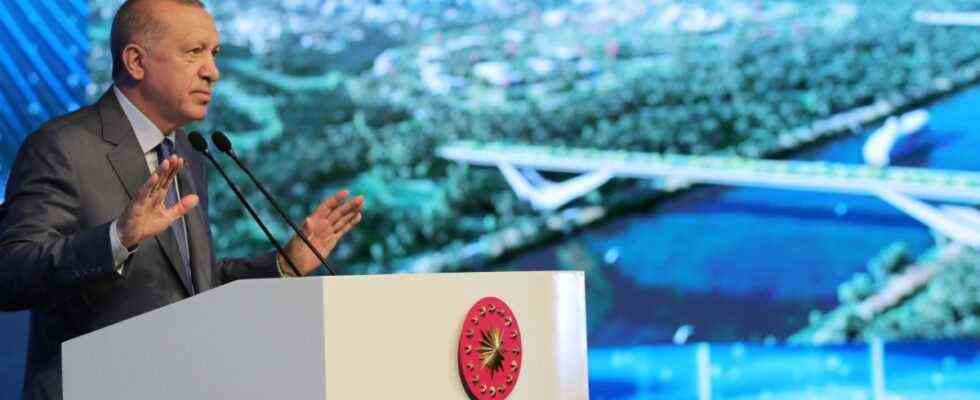With the politically controversial “Istanbul Canal”, Turkish President Recep Tayyip Erdoğan wants to secure the future of a “large and strong Turkey”. When laying the foundation stone for the first of seven bridges over the planned canal, which is to run parallel to the Bosphorus, Erdoğan said: “We see the canal as a project that will secure the future of Istanbul.”
The artificial waterway is a prerequisite for preserving the historical and cultural substance of the city of Istanbul, the former Constantinople. Currently, 45,000 ships a year passed the natural waterway across the city of 16 million people. By 2050 there would be 78,000 cargo and warships. The President emphasized: “Every single large ship on the Bosporus puts the city in serious danger.”
The planned canal overshadows all of Erdoğan’s previous construction projects and has been heavily criticized by the opposition and civil society for years because of the foreseeable threat to the environment. His opponents accuse the head of state of pursuing his unrealistic and environmentally insane project all the more because his electorate is rapidly declining and the populist Erdoğan wants to impress the voters.
The canal is Erdoğan’s most controversial infrastructure project. In his almost 20 years in power, first as Prime Minister and then as President, he has left his mark on Turkey as the political builder of several mega-projects. These include the new major Istanbul airport, a third bridge over the Bosporus, two tunnels under the strait and two huge mosques in Istanbul.
Former Prime Minister Binali Yıldırım had stated in his address that Erdoğan and his ruling party, the AKP, had wanted to build “seven large structures for the seven hills of Istanbul” from the start of their reign. The last of these is the planned canal, according to Yıldırım: “It should bring happiness and prosperity to the Turkish people.”
Erdoğan himself speaks of a “crazy project”
Because of the alleged overloading of the Bosporus by international merchant shipping, a 45-kilometer-long canal channel is to be dug parallel to the natural strait on the European side of Istanbul. A town with a total of 500,000 inhabitants is to be built on both banks. There are also port facilities and loading stations for freight traffic, but also marinas, luxury residential complexes and resorts. Parts of the business and economic life are to be moved out of Istanbul and connected to the new residential areas.
Erdoğan himself always justified the project he announced in 2011 and repeatedly presented as a “crazy project” with the fact that the dense shipping traffic on the Bosporus had made the risk of accidents incalculable. Because of the many oil tankers, cargo ships and the warships passing through the city full of weapons and ammunition, the city of Istanbul, a metropolis of 16 million people, is threatened with a catastrophe with unpredictable consequences. The government cited the latest example of this danger that a 180-meter freighter collided with a fishing boat on the Bosporus just a few days ago.
In reality, there have been no major accidents for a long time compared to previous decades because the central monitoring and logistics of shipping traffic on the Bosporus have been improved. A completely different environmental disaster, however, is currently occurring in the Marmara Sea. Because of the increased occurrence of plankton on the surface of the water, the water is slimy and almost asphyxiated for long stretches: the result of growing industrialization in the water itself and the sharp increase in population both in Istanbul and in the cities on the Marmara Sea.
The opponents of the Istanbul Canal – it is practically the entire opposition landscape of Turkey and a good part of the inhabitants of Istanbul – have long argued with the environmental consequences of the Canal for the immediate stop of all plans for the gigantic construction project. When the canal was built, the last remaining natural landscapes and forests on the edge of the giant city would be destroyed.
Cows peek by the water near the construction site for the bridge.
(Photo: Emrah Gurel / AP)
The canal also threatens to disrupt the metropolis’s water supply: the canal is supposed to run right through a reservoir, which supplies up to ten percent of the city’s drinking water. Other water reservoirs would also become too saline or cut off by the seawater in the canal. The remaining agricultural areas also threatened to become too salty.
Turkish and international environmental experts have long warned that the water exchange between the Black Sea and the Marmara Sea across the Bosphorus would lose its natural rhythm through the parallel channel. The Bosphorus connects the Black Sea with the Marmara Sea. This in turn borders on the southwestern strait of the Dardanelles on the Aegean Sea and the eastern Mediterranean.
The natural exchange of water between the two seas is regulated by the almost 40 kilometers long and between 36 and 124 meters deep Bosporus: the Black Sea is less salty and has more tributaries. The upper water layers in the Bosphorus flow southwest into the Marmara Sea, while the lower layers flow northeast into the Black Sea.
This allows the two seas to regenerate naturally. Such a natural mechanism does not work in a relatively shallow canal. As a result, the Marmara Sea would tip over and all marine life would become deserted or die off completely: According to experts, Istanbul and the Marmara Sea region would lie under a hood that smells of rotten eggs.

